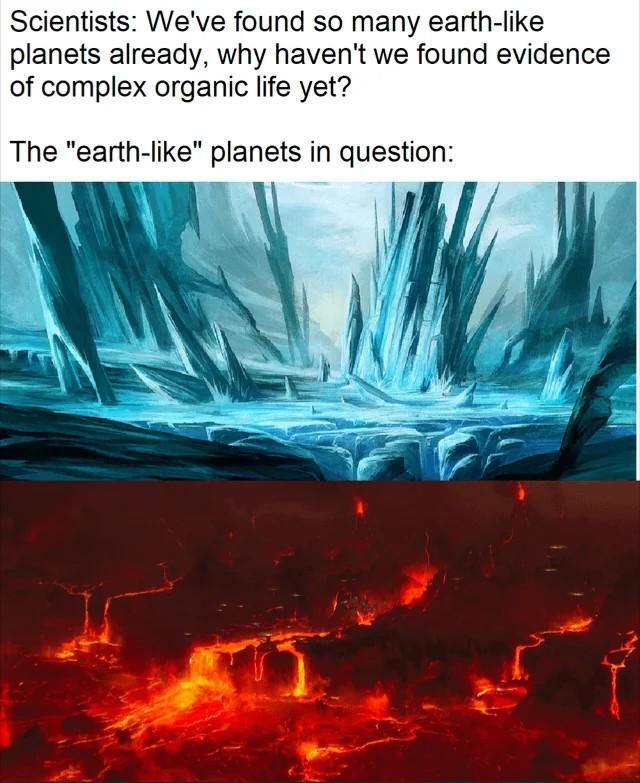this post was submitted on 26 Nov 2023
478 points (97.0% liked)
Science Memes
10356 readers
1983 users here now
Welcome to c/science_memes @ Mander.xyz!
A place for majestic STEMLORD peacocking, as well as memes about the realities of working in a lab.

Rules
- Don't throw mud. Behave like an intellectual and remember the human.
- Keep it rooted (on topic).
- No spam.
- Infographics welcome, get schooled.
Research Committee
Other Mander Communities
Science and Research
Biology and Life Sciences
- !abiogenesis@mander.xyz
- !animal-behavior@mander.xyz
- !anthropology@mander.xyz
- !arachnology@mander.xyz
- !balconygardening@slrpnk.net
- !biodiversity@mander.xyz
- !biology@mander.xyz
- !biophysics@mander.xyz
- !botany@mander.xyz
- !ecology@mander.xyz
- !entomology@mander.xyz
- !fermentation@mander.xyz
- !herpetology@mander.xyz
- !houseplants@mander.xyz
- !medicine@mander.xyz
- !microscopy@mander.xyz
- !mycology@mander.xyz
- !nudibranchs@mander.xyz
- !nutrition@mander.xyz
- !palaeoecology@mander.xyz
- !palaeontology@mander.xyz
- !photosynthesis@mander.xyz
- !plantid@mander.xyz
- !plants@mander.xyz
- !reptiles and amphibians@mander.xyz
Physical Sciences
- !astronomy@mander.xyz
- !chemistry@mander.xyz
- !earthscience@mander.xyz
- !geography@mander.xyz
- !geospatial@mander.xyz
- !nuclear@mander.xyz
- !physics@mander.xyz
- !quantum-computing@mander.xyz
- !spectroscopy@mander.xyz
Humanities and Social Sciences
Practical and Applied Sciences
- !exercise-and sports-science@mander.xyz
- !gardening@mander.xyz
- !self sufficiency@mander.xyz
- !soilscience@slrpnk.net
- !terrariums@mander.xyz
- !timelapse@mander.xyz
Memes
Miscellaneous
founded 2 years ago
MODERATORS
you are viewing a single comment's thread
view the rest of the comments
view the rest of the comments

The Milky Way galaxy is "only" 100.000 light years across, so any planets we see around stars in our galaxy we would only see about at most 100.000 years in the past. So it would be very unlikely there would be detectable life now, where there wasn't 100.000 years ago. And even if there were, it wouldn't be complex life.
The most distant exoplanet we've found to date is 27.710 light years away, so we see that planet as it was 27.710 years ago. We've had humans running round for at least a 100.000 year on Earth, so if there are any aliens on that planet we would see them.
Almost forgot the mandatory XKCD reference: https://xkcd.com/1342/
It's worth mentioning that we can't "see" any exoplanets at all. We know they are there by the gravitational lensing that occurs when a planet passes in front of the star it orbits. Once we calculate the position and orbit, we can track the planets and listen for any radio waves or radiation that would indicate life. We are also getting better as guessing the chemical composition of the planets, but it's not like we can scan the surface for plants and animals.
That's one way of detecting exoplanets, but not the most common one.
There are a couple of ways we can detect exoplanets:
We can see a wobble in the position of the star, as the star and the planet orbit around their common center of mass, which is offset from the center of mass of the star due to the mass of the planet.
Another way is to observe the light from a star, as the planet passes in front of the star some of the light gets blocked by the planet. By measuring the time and amount of light blocked, we can tell a lot about what is doing the blocking. The benefit of this method is some light passes through the atmosphere of the planet (if it has a significant atmosphere), by analyzing the spectrum we can tell what the atmosphere is made from.
We can also literally see a planet by direct observation, by blocking out the light of the central star, we can see light bouncing off the planet and observe that directly. This is hard, but has been done with several exoplanets.
There are more ways, see this Wikipedia article as a jumping off point for learning all about it: https://en.wikipedia.org/wiki/Methods_of_detecting_exoplanets
There's always a relevant xkcd!
Yeah I didn't know we were mostly looking at planets in the Milky Way, but it makes sense. Rocky planets are very tiny compared to other stuff in the universe so it's gotta be hard detecting them millions of light years out.
Yeah it's hard to even make out individual stars in other galaxies, let alone planets around them.
Only chance we have of seeing life in other galaxies is if they have built stuff like Dyson swarms.